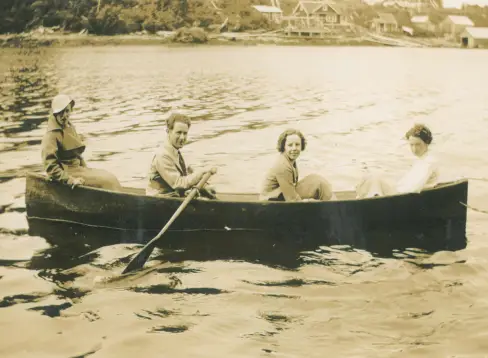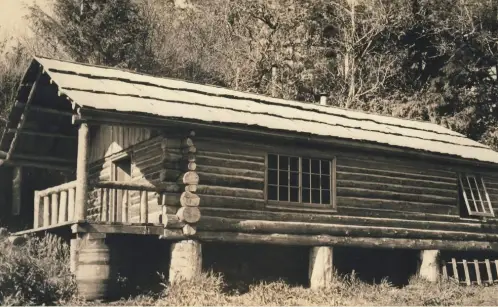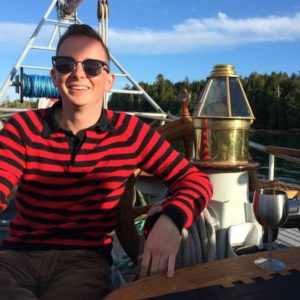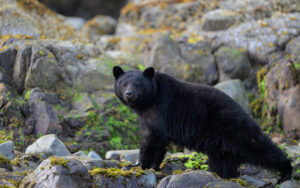
As we prepare to welcome our inaugural guests to Outer Shores Lodge this spring, we wanted to start sharing stories about the history of the lodge, and the site on which the lodge sits. The place has a remarkable past with innumerable stories dating back thousands of years. This incredible locale has gone through many iterations over time and the site has served several purposes throughout its history. We look forward to sharing many of those stories with our readers and guests in the months and years to come. Whether in Logbook posts like this, or during our excursions, or while seated around the campfire, or watching the unbelievable sunsets.
As the newest caretakers of this awe-inspiring place, we believe it is our responsibility to do our best to gain a full appreciation and understanding of its history. Operating on the traditional territories of the Huu-ay-aht, Tseshaht, Ucluelet, and Toquaht First Nations, with Outer Shores Lodge itself located on the traditional Huu-ay-aht village site of “ootsuu-a,” our team is deeply committed to providing a tourism experience that reflects the interests of the Huu-ay-aht First Nations and respects the original occupants of the site.
As those who have travelled with Outer Shores Expeditions before know, we’re committed to exploring and discovering the ecology and history of a place the best that we can, and then sharing that knowledge with our guests. Here at the lodge, we’ll be exploring the history of Bamfield, the natural history of the region, the histories of the many people who have called this location home, the life and legacy of the lodge’s founder – R. Bruce Scott – and the various people that have been connected to the site across the years.
Russell and Scott (Outer Shores Lodge’s new owners and operators) even have their own personal history with the lodge dating back a couple of decades, having taught coastal ecology and led research programs here when it operated as an outpost for the US-based School for Field Studies.
We thought the most logical place for us to start exploring the history of Outer Shores Lodge was with the individual who founded the original eco-lodge on this site and was crucial in creating Pacific Rim National Park. Our sincere gratitude goes out to the Bamfield Historical Society, who have done tremendous work through the years cataloging and communicating the R. Bruce Scott story and highlighting his many accomplishments as an advocate for this region and an integral voice in the importance of conservation across these outer shores of British Columbia.
Bruce Scott’s Journey to Bamfield
Robert Bruce Scott’s story starts far from Bamfield, British Columbia. It begins half a world away, in Sydney, Australia. Young Scott – at the age of just 13 years old – took a job with the Pacific Cable Board company in Sydney. After a number of transfers throughout the company, moving all around his native Australia, Scott found himself unfulfilled by life in Australia.
“I seemed like a lost soul, seeking something I knew not what exactly, and so in that spirit I applied for Canada, which always had a romantic appeal to me,” Bruce would later remark.
His application for a transfer to Canada was granted and soon the young Australian found himself stepping off the boat in the remote fishing village of Bamfield, British Columbia and immediately forging a connection with the place.
“It was a case of love at first sight,” Bruce said of his arrival in Bamfield. Within hours he was exploring the many forest trails in the area, something he says he did every day after that while he was working at the Bamfield Cable Station.
As the Bamfield Historical Society notes, the Bamfield to Fanning Island section of the “All Red Route” was the longest underwater cable in the world and the Bamfield to Montreal section was the longest above ground section. Bamfield served as a relay station between these two points. Scott was such a skilled cable board operator that Time magazine even noted his impressive errorless transmission record in an article about human error in electro-mechanical messages.
Bruce Scott’s First Cabin on the Outer Shores Lodge Site

But as skilled a cable board operator as Scott was, his true passion was for the natural world around him. He built a small log cabin on the site where Outer Shores Lodge sits today, expanding it at the behest of his wife, Pauline Head, whom he met when she came to Bamfield as a tourist via the Princess Norah cruise ship and married in 1942.
As we mentioned earlier, the site on which Scott built his home had been the former site of two Huu-ay-aht long houses, and Scott always felt that he and Pauline were not owners of the property, but rather caretakers of a truly special location. He kept an open invitation to all First Nations people and others to come and enjoy the property as well. His commitment to sharing the beauty and joy he found in the region would only grow from there and reach so far as the Canadian Prime Minister’s office. More on that in our future Logbook entries.
Stay tuned to our Outer Shores Insiders newsletter and across our social media channels as we continue to share the story of R. Bruce Scott and the many other people whose stories intersected and connected with this incredible place over thousands of years.








